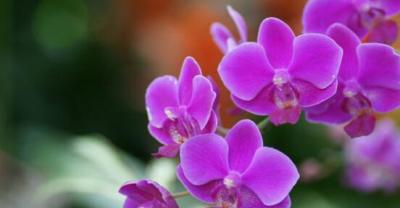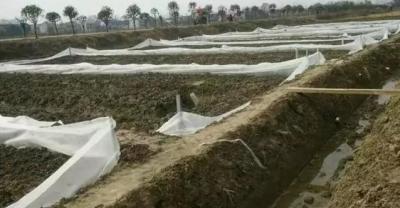Matters needing attention in the Culture of Phalaenopsis, the Queen of Jiao Yanlan
In general, orchids appear in light and elegant colors, but not many orchids appear in bright dark pink like Phalaenopsis. How to raise Phalaenopsis with elegant and varied colors? Let's learn about the matters needing attention in Phalaenopsis culture.

1. Flowerpots of Phalaenopsis: tile pots, plastic pots, etc.
Tile pots and plastic pots are generally used in large-scale production. In addition to tile pots and plastic pots, glazed pots and decorative pots are also used for family decorative cultivation. Large-caliber plastic pots and decorative pots are used to combine pots in flower supermarkets and flower shops. As a bedroom hanging basin to watch, you can also use boxes and snake boards. Container materials such as tile pots, glaze-rimmed pots, decorative pots and snake boards must be soaked in water before planting.
2. Phalaenopsis cultivation substrate: loose, permeable bark, water moss and other matters needing attention.
The cultivation substrate of Phalaenopsis must be loose, ventilated, permeable and resistant to rot. At present, the most commonly used cultivation substrates are bark (or bark silk), water moss, coconut shell, vermiculite, fern and so on. The mixed matrix of water moss and bark silk is commonly used in Japan, the artificial substrate produced by textile scraps is widely used in Taiwan Province of China, the mixed substrate of tree fern, water moss and sand is used in the United States, and coconut shell is mostly used in Thailand.
3. Phalaenopsis family culture temperature note: like warmth
When Phalaenopsis is cultivated at home, the selected orchid must be flowering, and it must be full, with a minimum requirement of more than 15 ℃ at room temperature and good ventilation. If the indoor temperature is more than 20 ℃, you can spray the orchid plant to cool down or move into a cooler room temporarily in order to prolong the flowering period. When the temperature exceeds 15 ℃ in the morning of May in spring, the orchid plant can be moved to the outside for maintenance. The orchid plant was moved indoors before the temperature dropped to 15 ℃ in the morning of September in autumn.

4. Phalaenopsis family culture light attention: like semi-overcast
Phalaenopsis has formed the habit of liking semi-shade in the natural environment. Shading time can be adjusted by shading net or bamboo curtain in family cultivation. When the sun and temperature are high in summer, the shading time is longer, about 70%. When the sun is weak and the temperature is low in winter, it is appropriate to shade at noon, and the covering time is controlled according to the weather changes in spring and autumn. There is no need for shading from evening to sunrise in the morning. This is good for ventilation.
In short, the cultivation of Phalaenopsis must avoid strong light direct or exposure, the leaves are easy to burn, similarly, fixed shade for a long time, resulting in weak light, delicate growth of orchid plants, tender leaves, elongated flower stems, lack of luster and not bright flowers, and are also prone to disease. For this reason, artificial light should be added when there is a lack of rain and snow for a long time in winter.
5. Phalaenopsis family culture watering attention: like wet, avoid stagnant water
Phalaenopsis likes to be wet, but avoid stagnant water. Watering must be determined according to the season, air temperature, cultivation substrate and the growth and development of orchid plants. Generally speaking, when the temperature is slightly higher from June to September, Phalaenopsis is in a prosperous period of growth, you can water more water, choose sunny morning watering, the cultivation substrate can be moist. When the temperature is low in winter and spring, it is necessary to irrigate less, keep the root a little drier, and water again when the substrate in the basin begins to dry. If the temperature is lower than 15 ℃, watering should be strictly controlled. However, in winter during the flower bud growth period, as long as the temperature is not lower than 18 ℃, it should be watered in time, with the bottom matrix moist as the degree, do not let the basin too wet.
In the pot substrate, water moss and bark silk generally absorb more water, the watering interval can be longer, the drainage of bark and vermiculite is good, and the watering interval should be short.
During the growing period of Phalaenopsis, especially in high temperature and dry season in summer and autumn, you can spray more water, but be careful not to make the core of orchid leaves accumulate water, especially in winter night, it is forbidden to spray water on leaves.
In fact, Phalaenopsis culture is not difficult, as long as the appropriate temperature, fertilization should be appropriate, appropriate light can promote Phalaenopsis flowering, so that the flowers are gorgeous and lasting, generally should be placed indoors where there is scattered light, do not let direct sunlight.
-BIU~BIU~BIU~, I'm the dividing line.-if you are planning to decorate, please pick up your phone and follow our Wechat! Editor's personal number: 13775489929 every day to share the decoration strategy and case design, follow the Wechat official account: lygyhjjw [follow the editor to help see the household model! The design scheme of free housing in 69 cities across the country]
- Prev

Apiculture technology apiculture 50 noun explanation
1, apiculture: is the study and analysis of bees a variety of insects, mainly including bee biology, bee breeding, nectar botany, honey...
- Next

Key points of Frog Culture techniques
First, the successful case of frog farming at the end of 2014, Wang Anwei and other three people jointly invested 150000 yuan to set up a frog farm, leasing 7 mu of paddy fields, digging ditches and weaving encirclement.
Related
- On the eggshell is a badge full of pride. British Poultry Egg Market and Consumer observation
- British study: 72% of Britons are willing to buy native eggs raised by insects
- Guidelines for friendly egg production revised the increase of space in chicken sheds can not be forced to change feathers and lay eggs.
- Risk of delay in customs clearance Australia suspends lobster exports to China
- Pig semen-the Vector of virus Transmission (4)
- Pig semen-the Vector of virus Transmission (3)
- Five common causes of difficult control of classical swine fever in clinic and their countermeasures
- Foot-and-mouth disease is the most effective way to prevent it!
- PED is the number one killer of piglets and has to be guarded against in autumn and winter.
- What is "yellow fat pig"? Have you ever heard the pig collector talk about "yellow fat pig"?

